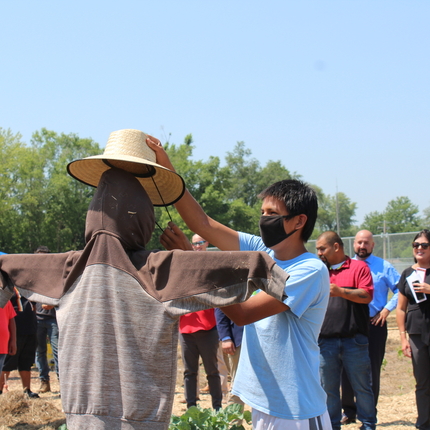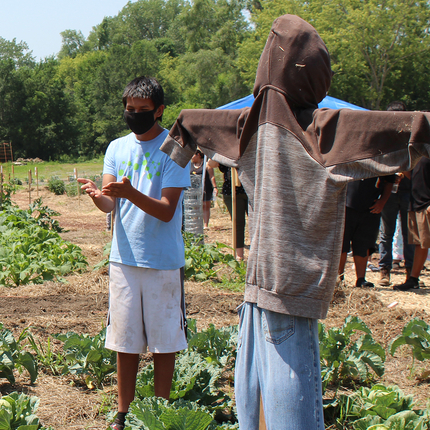By Justin Carter, former staff member
Incoming sophomore student Donovon Hastings at UMÓⁿHOⁿ (Omaha) Nation Public School, in Macy, Nebraska, has come to love working in his cabbage patch. He keeps it well manicured with not a weed in sight. One of his goals is to grow the biggest cabbage possible.
Donovan is one of a group of students who have spent their summer working in the Àshi ta Théwathe (Let’s Go Outside) Program on UMÓⁿHOⁿ Nation’s newly cultivated garden.
The garden is no small undertaking. Numerous plots occupy multiple acres with offerings including tomatoes, zucchini, greens, potatoes, radishes, and others. Traditional blue corn grows high in one portion of the garden with another dedicated to the Three Sisters: corn, beans, and squash grown together. These three crops represent a meaningful facet of Indigenous culture and foodways.
In early 2020, UMÓⁿHOⁿ Nation Public School was given the opportunity to use seven acres of land from the UMÓⁿHOⁿ Tribe to cultivate food. Officials were ecstatic; they had already grown their program to include raised garden beds and built a greenhouse. Seven acres of land would mean larger scale cultivation to feed students and the community. Unfortunately, COVID-19 soon halted their plans with only 5 gallons of corn harvested in 2020.
This year has proven to be different. When ground broke in spring 2021, educators like Delberta Frazier, Brenda Murphy, and Ricardo Ariza sprang into action with 20 students to form the Against the Current Program. Both students and teachers have worked throughout the summer—often through temperatures exceeding 100 degrees—to grow a garden of pride.
The Center for Rural Affairs has been right alongside them—providing technical assistance as necessary.
In addition to cultivation, students have learned important lessons of their culture and language. Vegetables throughout the garden include labels of their names in UMÓⁿHOⁿ language, and lessons include the significance of Indigenous connection to food and environment.
The spirit of community also lies in the garden as many of the crops go directly to local residents. For example, Delberta gives tomatoes to a neighbor.
“It has always been a dream of mine to feed our people, and we’re starting to see that as a reality,” said Delberta, who has taken part in the garden since its inception.
Although not all 20 students return to the garden daily, the ones who do are fiercely dedicated to it. As Donovan tends to his cabbage and makes tomato cages, he says his favorite part of the garden is helping people.
Feature photos: Donovon Hastings, sophomore at UMÓnHOn (Omaha) Nation Public School, has a goal to grow the biggest cabbage possible. He is pictured here placing a hat on a scarecrow in the cabbage patch. | Photos by Rhea Landholm





